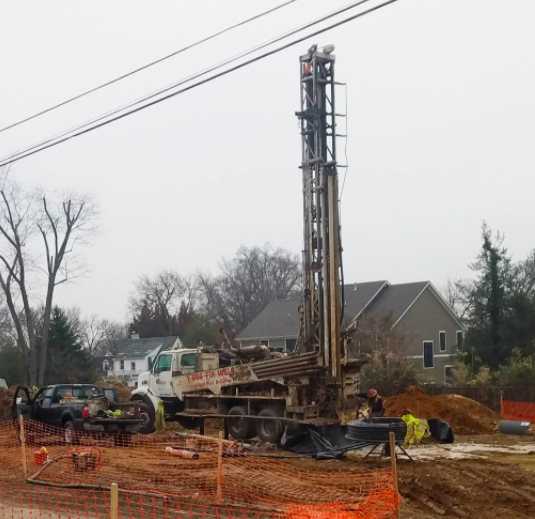The brand new geothermal Mason

The commencement of drilling for the geothermal holes when the construction of the new school began. (Photo courtesy of Kate Ward)
May 20, 2021
Outside the new George Mason High School, the view is majestic. Towering wings, expansive terraces, and stretching windows fill your view. The features of this massive new $120 million building go on incessantly. But one of the most unique and interesting features of the campus lies beneath the school in the form of some 180 500 foot deep geothermal wells, the first large-scale geothermal project of the Little City.
Geothermal energy is used to capture the thermal energy stored deep in the earth. This thermal energy stems from the earth’s core, where temperatures reach similar levels as the surface of the Sun. These wells are deep enough to capture this thermal energy and put it to use in heating. In the summer, air is brought up from just over 4 feet underground to cool the building as opposed to the 500 foot wells used during the winter.
“Metropolitan Washington’s mean ground temperature is 56° F year-round,” said Kate Walker, the environmental programs coordinator for the City of Falls Church, about the project. “GHPs (Geothermal Heat Pumps) use the ground as a “heat source” for heating in the winter; and as a “heat sink” for cooling in the summer. GHPs move fluids through continuous pipeline loops that are buried underground and deliver conditioned air through heat pump equipment serving the various parts of the building.”
The idea of this project is to achieve net zero energy in the new school. But the advantages don’t stop there.
“The long-term advantages of moving toward ZEBs (Zero Energy Buildings) include lower operating and maintenance costs, lower environmental impacts, better resiliency to power outages and natural disasters, and improved energy security. Schools that incorporate energy efficiency and renewable energy technologies make a strong statement about the importance of protecting the environment,” Ms. Walker said.
Geothermal energy releases one sixth of carbon emissions that a natural gas plant produces, making it extremely environmentally friendly. It also requires considerably less electricity than other heating and cooling opportunities.
The use of geothermal energy, although costly at first, ends up being a much sounder long term investment as the school is now in control of its own heating and air without reliance on an outside product. The air in a geothermal system is pre-warmed in winter, and pre-cooled in summer, which leads to a system that requires less energy input and less carbon emissions. Despite this unconventional approach to heating and cooling, there are still drawbacks.
“The initial cost of installation was higher than a more conventional heating, ventilation and air-conditioning system,” Ms. Walker said. “It is a new type of system for our schools’ buildings, so we need ongoing support and special training to be able to operate and maintain it properly.” With this being the first big geothermal project in the city, Ms. Walker explained that the project began much earlier than construction began, with a feasibility study in partnership with Oak Ridge National Laboratory and the Metropolitan Washington Council of Governments. “With data from the study, we then had to persuade the design-and-build team to find the right experts to help them implement the idea.”
And as the school becomes used full time, the temperature has remained perfect.








